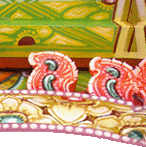




Since the body and mind are the gift of the Divine, the Tantric science teaches one to cherish life. Only by living life to one's total potential can one exhaust the desire to be reborn. Only then can we absolve karma; that is, our involvement with the limited aspect of the world into which we desired to be born. The Tantras teach us that one is not born by chance but in accordance with the Divine Will (see Manu's Manava Dharma-śāstra). Thus, we should be mindful of our spiritual nature and not live whimsically believing in the limitations of our finite birth (as mere bio-organisms). By realizing our spiritual nature, we attain our true potential and own nature (svadharma).To observe a spiritual life, we need to fulfill certain duties (saṃskāras) that enhance and develop our potential as human beings. Tantricism asserts that if we don't live life to our full potential, we will not fulfill the purpose of our birth. The noninvolvement and therefore nonfulfillment of life is adharma, and its antidote is the fulfillment of life (dharma). The nonfulfillment of life is understood as falling into the traps of karma. This void or nonperformance of dharma is the cause of rebirth. Due to this, the Tantras teach us to live a total life. This is quite different to the contemporary interpretations of Buddhism, which advocate the avoidance of participating in life's course.
Dharma is the honoring of your true self (not dysfunctions). Tantra teaches that we are born to express our true nature, i.e. a cat living as a cat, not anything else. Dharma then is living your life to its fullest. In realizing one's true nature or dharma, one understands one's true potential or artha. Artha relates to those things that enable you to fulfill your potential as a human being i.e. your home, tools, food, etc. Tantrics see these as vital for one's existence as a human being. Unfortunately, our contemporary knowledge conveys a dichotomised notion of matter as against spirit and this forces us to base our existence on one of these notions (matter) at the expense of the other (spirit). Kāma is one's innate bliss. Children express this bliss in play, and as adults they engage in meaningful relationships.
By living one's dharma, one overrides one's finite limitations (karma). There is no other way out of the entrapments of karma. The completion of one's purpose of birth (dharma) naturally leads to liberation/salvation or mokṣa.
Shri Kali Ashram teaches the spiritual science of Shaivism. Since it teaches a complete science, this Shaiva-Shakta Ashram teaches both the Right-hand and Left-hand Tantras. The path that is known as Right-hand Tantra (Dakṣiṇa Marga) is where one learns to live life as a complete human being and honor a single partner. What is presently known as Left-hand Tantra (Vāma Marga) is the Goddess worship. This includes the Vāma, Kula, Kaula, and the Krama (aspirants who want to live by the inner secrets of Tantricism). The inner secrets of Tantricism are for those practitioners (sādhakas) who aspire to live completely as spiritualists. Indeed, the Left-hand Tantrics do not stop at becoming perfect human beings but aspire to become perfect spiritual beings. In the process, they resolve all aspects of humanity (including sexuality) according to the spiritual philosophy of the specific goddess they worship (puja). In this ashram we initiate (dīkṣā) one into the science of Vāma, Kula, Kaula, and Krama Tantricism. Tantricism is the esoteric secrets (rahasya-sampradayā) of Shaivism. The other Āgamas (Vaiṣṇavism, Bauddha or Buddhist) too have within their corpus of observances the science of Tantricism.
© Copyright 2004. All Rights Reserved. Bhagavan Shri Shanmukha Anantha Natha and Shri Ma Kristina Baird.
Last update: Date and EST Time in Florida, Miami, USA: 21st January 2026 07:18:04 AM
TANTRA | PUBLICATIONS | TEACHERS | TRAINING | WORKSHOPS & RETREATS | SCHOOL | SHAIVA JOURNAL | ASANAS | LOCATION | HOME